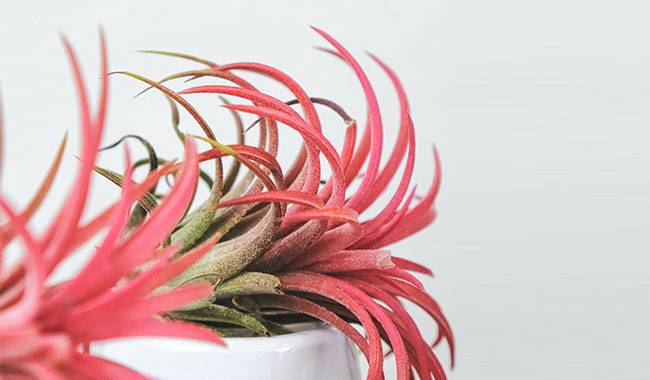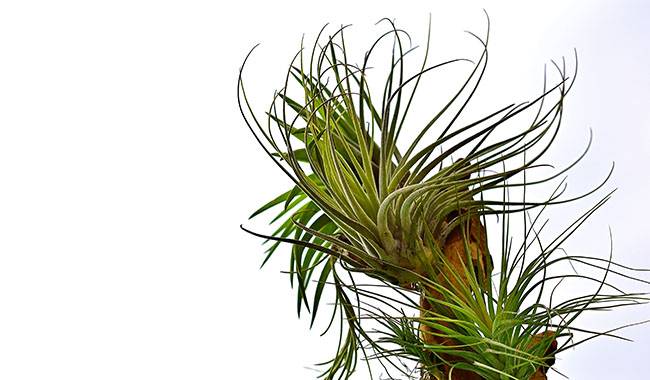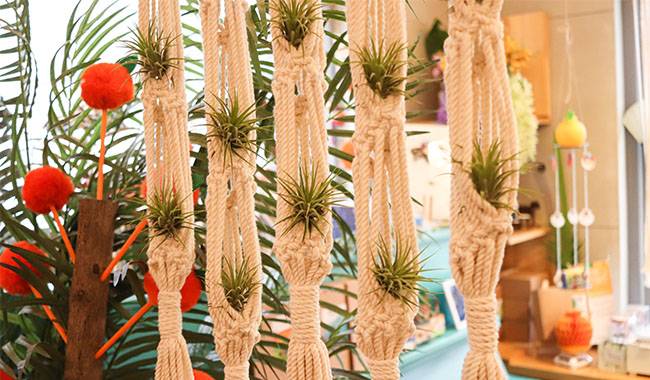
Of all the Tillandsia Flowers in the house, not coincidentally, Tillandsia Flowers are considered the most elegant. Bright, flat inflorescences with single, contrasting and exotic flowers sticking out from the side attract admiring glances at all times. The less simple disposition of Tillandsia flowers does not prevent them from continuing to be popular. But fraternization has its drawbacks – Tillandsia Flowers are often bought for a few weeks and then unceremoniously thrown away. This epiphyte deserves more. With the proper lighting and a less laborious arrangement of optimal humidity, Tillandsia will thank you generously with beautiful foliage and large inflorescences.
TILLANDSIA FLOWER – PLANT DESCRIPTION
One of the most famous members of the Anemone family, Tillandsia Flower, is the most popular Anemone, a typical herbaceous epiphyte. Evergreen, showy, and with beautiful foliage, it is no coincidence that it is one of the most decorative species for modern interiors.
Tillandsia is a genus of evergreen, perennial flowering plants in the Anemone family, with about 650 species native to forests, mountains, and deserts in northern Mexico and the southeastern United States, Central America, and the Caribbean to central Argentina.
The root system of Tillandsia Flower is reduced and sometimes completely absent, serving only as a support. The shortened stems are usually inconspicuous. The stiff leaves, spirally arranged in a rosette, are the focal point of the plant. The width of the rosette is generally greater than the height, and a strong, vigorous Tillandsia can have a rosette that extends to a circumference of 23 inches (60 cm). Sword-shaped, slender, and gray due to the special silvery covering of the scales, the leaves of Tillandsia species have a perfect and noble appearance, often with a reddish tinge. They are 10 inches (25 cm) long and only 0.6 inches (1.5 cm) wide.
Tillandsia Flower blooms in summer and autumn. In many hybrid cultivars, flowering is easily replaced, and flowering Tillandsia is sold all year round. Indoor plants bloom most often in the summer. As with other bromeliads, once the parent rosette dies, it is replaced with a daughter rosette within 1-2 years and can bloom after an average of 3-4 years.
The flowers of Tillandsia Flower are far less eye-catching than the bracts in the inflorescence. The slender tubes, gracefully curved, reach about 1 inch (2.5 cm) in diameter, and the intense ultramarine “bells” stand out against a background of huge “cones.” The spikes of dense, flat inflorescences, up to 6 inches (15 cm) long and up to 2 inches (5 cm) wide, are formed by huge, thick, mostly pink or lavender bracts. There are about two dozen flowers in an inflorescence, which is hard to appreciate. Even a few flowers together rarely open, and only one flower on a Tillandsia Flower is the most common.
OTHER TYPES OF TILLANDSIA
Better known as Spanish moss or road Spanish moss, Tillandsia usneoides do not resemble Tillandsia or another well-known bromeliad. Instead, it is a very special and extravagant plant for growing in a florarium or greenhouse. This species has long, densely branched, thin stems that form peculiar “whiskers” or “sponges,” along with narrow, linear leaves up to 2 inches (5 cm) long, covered with soft scales.
This species is grown “permanently” by tying it to a stump or branch without transplanting. It is a rootless plant that survives only in high humidity environments, absorbing nutrients and water only from the air. Therefore, Tillandsia requires a sheltered environment, a constant temperature of 64-70 °F (18-21°C), sprays, and showers.
Other species of Atmospheric Tillandsia.
- Tillandsia caput-medusae or Tillandsia caput-medusae is a thick-leaved, whimsical species with red inflorescences.
- Tillandsia argentea is a species with unusually curved, prominent thin leaves with a silvery effect.
- Tillandsia ionantha is an elegant rosette with silvery curved leaves that turn red under purple spikes.
GROWING CONDITIONS FOR TILLANDSIA INDOORS

Tillandsia is more comfortable in store windows, decorative flower rooms, and greenhouses than living rooms. This is not without reason: the plant not only depends on air humidity but also prefers stability.
Lighting and placement
Uniform greenhouse lighting, artificial backlighting, and mild conditions are ideal for Tillandsia Flower. A comfortable place in the room can be found only in the eastern windows; in summer, also in the northern ones. The western and southern directions need screens to prevent direct sunlight and overheating. If the Tilland bird is to be displayed indoors, it is worth keeping it within 40-60 inches (1-1.5 m) of the soft light of the south window.
In winter, the light of Tillandsia can be increased to compensate for seasonal problems. The minimum length of daylight is 12 hours.
This plant should not be unnecessarily touched or disturbed. Tillandsia needs space that will allow them to grow evenly. Make sure there is enough space so that no leaves are pressing down on anything.
Temperature control and ventilation
Tillandsia flowers do not like heat very much and prefer stable, moderate temperatures during active growth. A 70-77 °F (21-25°C) temperature is ideal for the active growth stage. From mid-autumn to spring, temperatures can but do not have to drop to an average of 64-70 °F (18-21°C). With comfortable humidity and supplemental light, Tillandsia Flower will overwinter well in higher temperatures.
In the case of cold air currents, this plant is not suitable. Drying is vital to the health of Tillandsia Flower.
Caring for Tillandsia at home
Tillandsia Flowers are typical of the bromeliad family, but it is best to avoid watering them in their sockets. Likewise, do not rush to prune, repot or overfeed.
Watering and humidity
Watering at the rosette will often lead to rot. Careful watering at the edge of the pot, with the top of the substrate slightly dry at 0.4 inches (1 cm), combined with spraying, is more suitable for plant growth. In winter, it needs to reduce watering, and the substrate will be a bit drier.
Always maintain a moderately high humidity level. Misting is beneficial but should only be done at temperatures above 64 °F (18°C). Place plants on a moist bed of moss or pebbles during heating systems and hot weather.
Fertilization and fertilizer composition
Tillandsia Flower is better suited for foliar feeding and should make up at least half of all applications. However, large doses of chemical fertilizers are dangerous, and the amount should be cut in half. Tillandsia flowers need fertilization during periods of vigorous growth, about once a month.
Special fertilizers for bromeliads or orchids are more suitable for this type of Tillandsia Flower.
Pruning and trimming Tillandsia
Cut off damaged and yellowed leaves in case of problems. Inflorescences should be completely cut off when the pedicel is completely dry, all the way to the base.
Wilted mother rosettes can be removed when repotting after dying. However, buds may take up to 2 years to emerge. And it is best to leave them on the parent rosette for as long as possible.

Transplanting, containers and substrates
In the case of Tillandsia, transplant them only if they need to be divided due to lack of space, if the offspring rosettes have grown enough to reproduce, or if the substrate has wholly lost its properties and needs to be replaced urgently. They should not be unnecessarily disturbed; the roots are fragile, and only the dead female rosettes need to be removed from the center. When transplanting, can place all the daughter plants together, or the Tillandsia can be separated. The plant can be transplanted at any time of the year except winter.
Deep containers are not suitable for this Tillandsia Flower. The shrinking root system requires low but relatively flat containers. Too much substrate mass is detrimental and increases the risk of plant decay and loss.
You can use a special substrate for bromeliads or make your own peat-based potting soil mixture to which you add equal amounts of crushed stone peat and bark (or you can use orchid soil and add stone peat and peat to the mixture). Most of all, the substrate needs to be coarse-textured, breathable, acidic, or slightly acidic, with a pH between 3.0 and 6.0.
When transplanting Tillandsia, the substrate should be kept at the submerged level. Watering should be limited after the soil change, but air humidity should be maximized, and plants should be protected from bright light. Feeding should not be resumed until active growth begins after 4-5 weeks.
Pests and problems in cultivation
Tillandsia Flower is virtually unaffected by pests, the most common being plant loss due to rot. Watering the rosette, watering underwater, water accumulation at the base of the leaves, and concentrated fertilization can all lead to rot. If you act quickly to dry out the plant, it is possible to stop the infestation. However, if the rosette base is severely damaged, it is impossible to save Tillandsia Flower, and all hope lies in the seedlings that may still emerge.
Propagation of Tillandsia
Growing Tillandsia Flower by itself from seed is possible but not always advisable. You have to wait several years for it to flower. It is pretty challenging to save and grow the fragile rosettes, which are extremely sensitive to fluctuations in air humidity. Once the lateral rosettes have developed their roots, it is much easier to separate them. It is easy to be guided by the size: the daughter rosettes should be almost the size of the mother rosettes.







